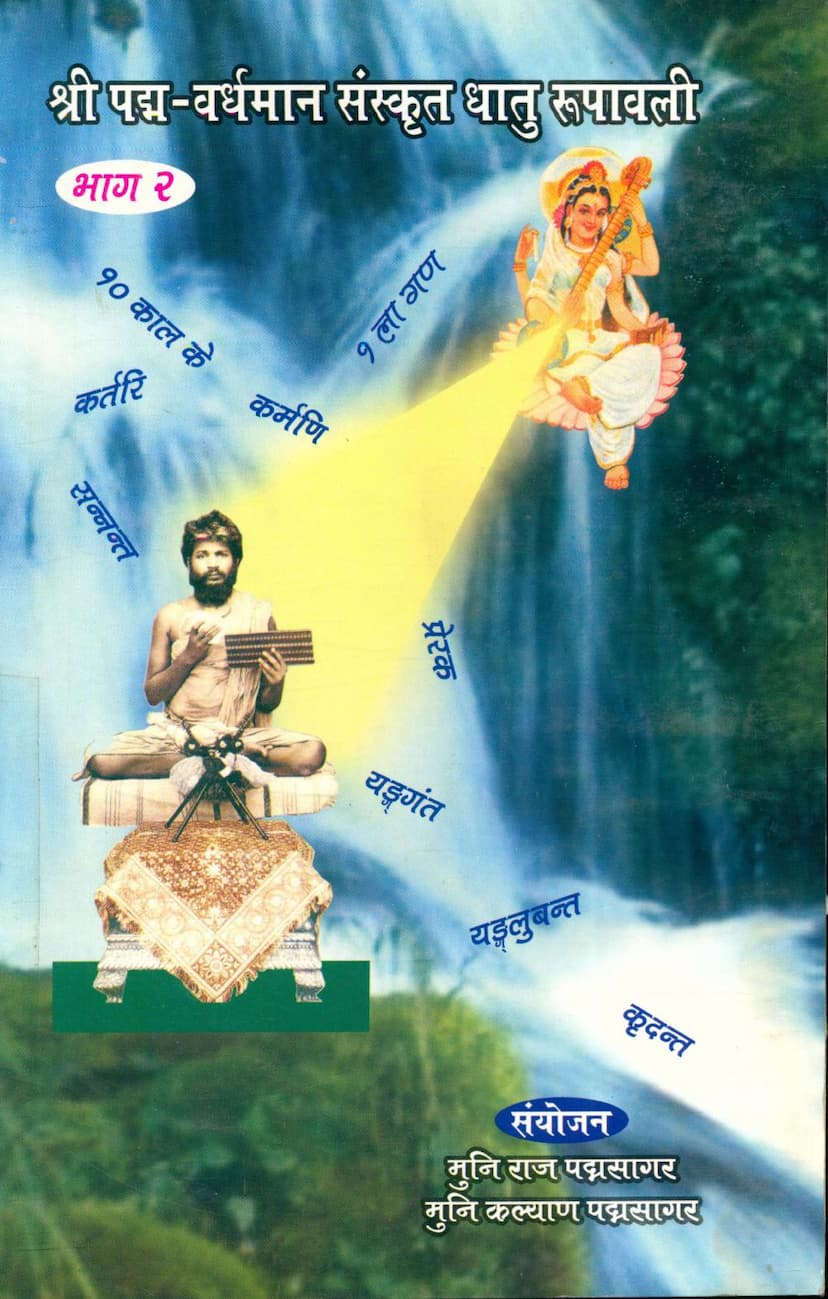Padma Vardhaman Sanskrit Dhatu Shabda Rupavali Part 02
Added to library: September 2, 2025

Summary
This document is a summary of the Jain text "Padma Vardhaman Sanskrit Dhatu Shabda Rupavali Part 02" authored by Rajpadmasagar and Kalyanpadmasagar, published by Padmasagarsuri Charitable Trust.
Here's a breakdown of the content based on the provided pages:
Book Information and Dedication:
- Title: श्री पद्म-वर्धमान संस्कृत धातु रूपावली भाग 2 (Shri Padma-Vardhaman Sanskrit Dhatu Rupavali Part 2)
- Authors: मुनि राजपसागर (Muni Rajpadmasagar) and मुनि कल्याणपसागर (Muni Kalyanpadmasagar)
- Publisher: आचार्य पद्मसागरसूरि चेरिटेबल ट्रस्ट (Acharya Padmasagarsuri Charitable Trust)
- Guidance/Inspiration: The book is dedicated to the divine grace of several respected Acharyas, including P.P.A. Shri Kailashsagar Surishwarji M.S., P.P.A. Shri Subodh Sagarsurishwarji M.S., and P.P.A. Shri Kalyan Sagasurishwarji M.S. It also mentions the auspicious blessings of Acharya Padmasagarsuri.
- Contributing Professor: Professor Shri Chiragbhai K. Shah is also mentioned.
- Purpose: The book aims to simplify the study of Sanskrit verbs (dhatus) for young learners, following the "Shri Hem Sanskrit Praveshika" curriculum. It provides various forms of verbs with their meanings, including Kartari (active), Karmani (passive), Sannanta (causative), Puraka (intensiv), Yaganta (denominative), Yaglubanta, and Kridanta (participial forms).
Content Overview:
The core of the book is a comprehensive dictionary or glossary of Sanskrit verbs, presented in a structured format. Each verb is listed with:
- Verb Root (Dhatu): The basic form of the verb.
- Class (Gana): Categorization based on Sanskrit grammar.
- Form (Pad): Indicating whether the verb is Parasmaipada (used with pronouns like "I", "you", "they") or Atmanepadi (used reflexively or for internal actions).
- Meaning: The literal translation of the verb.
- Various Verb Forms: This is the most extensive part, covering:
- Kartari Rupa: Active voice forms across different tenses.
- Karmani Rupa: Passive voice forms across different tenses.
- Sannanta: Causative forms, indicating the subject causes another to perform the action.
- Puraka: Intensified forms, indicating a stronger or repeated action.
- Yaganta: Denominative verbs formed from nouns.
- Yaglubanta: A specific type of reduplicated verb form.
- Kridanta (Kridantavali): Participial forms, used as adjectives or to describe actions.
Structure and Organization:
The book is organized by verb roots, presented in alphabetical order. It appears to cover a significant number of Sanskrit verbs, with a detailed breakdown of their grammatical conjugations and forms. The extensive lists of verb forms demonstrate a meticulous approach to Sanskrit grammar education.
Key Features Highlighted:
- Comprehensive Coverage: The book aims to be a complete resource for Sanskrit verb forms.
- Clarity and Simplicity: The purpose is to make learning Sanskrit verbs easier, especially for younger students.
- Grammatical Accuracy: Adherence to the "Shri Hem Sanskrit Praveshika" curriculum suggests a focus on grammatical correctness.
- In-depth Explanations: The inclusion of meanings and various verb forms provides a deep understanding of verb usage.
- Jain Context: The publication by a Jain trust and the presence of auspicious salutations ("Shri Adinathaya Namah!!") indicate the text is presented within a Jain philosophical and educational framework.
Additional Information:
- Publisher's Information: Details of the publisher, Padmasagarsuri Charitable Trust, including contact address and phone numbers in Ahmedabad, are provided.
- Publication Details: The first edition has a print run of 1000 copies. The publication dates are given in Vikram Samvat (VS 2064), Veer Samvat (VS 2534), and Gregorian calendar (2008 AD). The price is mentioned as ₹50.
- Distribution/Donation: The book is published through "Gyan Swate" (knowledge fund) and encourages those who benefit from it to contribute financially.
- Printer: Kailash Offset is mentioned as the printer.
- Related Institutions: The text extensively describes the "Shri Mahavir Jain Aradhana Kendra, Koba," highlighting its various facilities and attractions, including the Mahaviralaya, Gurumandir, Aradhana Bhavan, Mumukshu Kutir, Bhojanalaya, and the Acharya Kailasagarsuri Gyanmandir. It also briefly introduces the "Borij Tirth" as "Vishva Maitridham." These descriptions emphasize the charitable and educational mission behind the publication.
In essence, "Padma Vardhaman Sanskrit Dhatu Shabda Rupavali Part 02" is a scholarly and educational work aimed at providing a thorough and accessible guide to Sanskrit verbs, deeply rooted in Jain tradition and dedicated to the advancement of spiritual and intellectual knowledge.